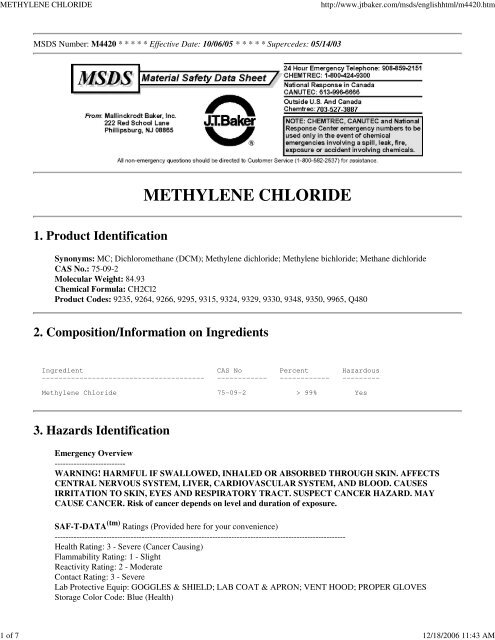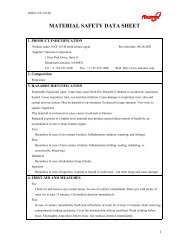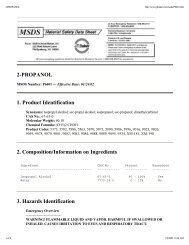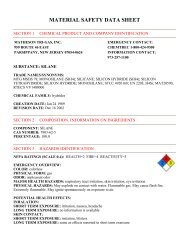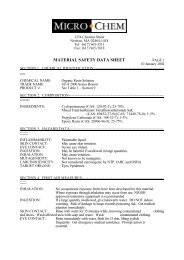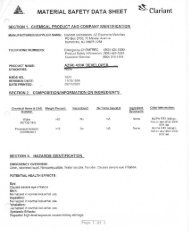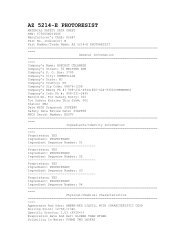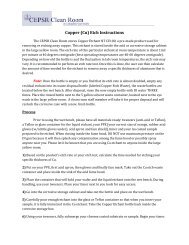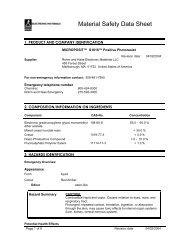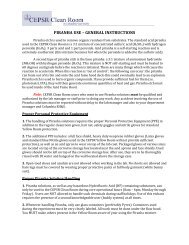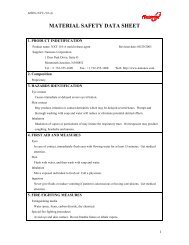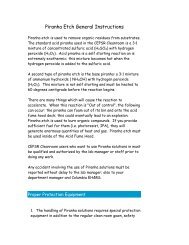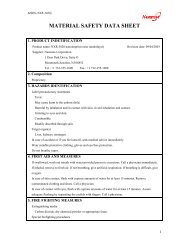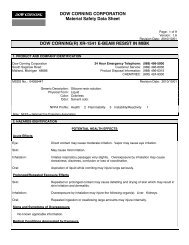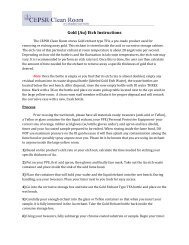METHYLENE CHLORIDE
METHYLENE CHLORIDE
METHYLENE CHLORIDE
Create successful ePaper yourself
Turn your PDF publications into a flip-book with our unique Google optimized e-Paper software.
<strong>METHYLENE</strong> <strong>CHLORIDE</strong>http://www.jtbaker.com/msds/englishhtml/m4420.htm1 of 7 12/18/2006 11:43 AMMSDS Number: M4420 * * * * * Effective Date: 10/06/05 * * * * * Supercedes: 05/14/03<strong>METHYLENE</strong> <strong>CHLORIDE</strong>1. Product IdentificationSynonyms: MC; Dichloromethane (DCM); Methylene dichloride; Methylene bichloride; Methane dichlorideCAS No.: 75-09-2Molecular Weight: 84.93Chemical Formula: CH2Cl2Product Codes: 9235, 9264, 9266, 9295, 9315, 9324, 9329, 9330, 9348, 9350, 9965, Q4802. Composition/Information on IngredientsIngredient CAS No Percent Hazardous--------------------------------------- ------------ ------------ ---------Methylene Chloride 75-09-2 > 99% Yes3. Hazards IdentificationEmergency Overview--------------------------WARNING! HARMFUL IF SWALLOWED, INHALED OR ABSORBED THROUGH SKIN. AFFECTSCENTRAL NERVOUS SYSTEM, LIVER, CARDIOVASCULAR SYSTEM, AND BLOOD. CAUSESIRRITATION TO SKIN, EYES AND RESPIRATORY TRACT. SUSPECT CANCER HAZARD. MAYCAUSE CANCER. Risk of cancer depends on level and duration of exposure.SAF-T-DATA (tm) Ratings (Provided here for your convenience)-----------------------------------------------------------------------------------------------------------Health Rating: 3 - Severe (Cancer Causing)Flammability Rating: 1 - SlightReactivity Rating: 2 - ModerateContact Rating: 3 - SevereLab Protective Equip: GOGGLES & SHIELD; LAB COAT & APRON; VENT HOOD; PROPER GLOVESStorage Color Code: Blue (Health)
<strong>METHYLENE</strong> <strong>CHLORIDE</strong>http://www.jtbaker.com/msds/englishhtml/m4420.htm2 of 7 12/18/2006 11:43 AM-----------------------------------------------------------------------------------------------------------Potential Health Effects----------------------------------Inhalation:Causes irritation to respiratory tract. Has a strong narcotic effect with symptoms of mental confusion,light-headedness, fatigue, nausea, vomiting and headache. Causes formation of carbon monoxide in blood whichaffects cardiovascular system and central nervous system. Continued exposure may cause increasedlight-headedness, staggering, unconsciousness, and even death. Exposure may make the symptoms of angina(chest pains) worse.Ingestion:May cause irritation of the gastrointestinal tract with vomiting. If vomiting results in aspiration, chemicalpneumonia could follow. Absorption through gastrointestinal tract may produce symptoms of central nervoussystem depression ranging from light headedness to unconsciousness.Skin Contact:Causes irritation, redness and pain. Prolonged contact can cause burns. Liquid degreases the skin. May beabsorbed through skin.Eye Contact:Vapors can cause eye irritation. Contact can produce pain, inflammation and temporal eye damage.Chronic Exposure:Can cause headache, mental confusion, depression, liver effects, kidney effects, bronchitis, loss of appetite,nausea, lack of balance, and visual disturbances. Can cause dermatitis upon prolonged skin contact. Methylenechloride may cause cancer in humans.Aggravation of Pre-existing Conditions:Persons with pre-existing skin disorders, eye problems, impaired liver, kidney, respiratory or cardiovascularfunction may be more susceptible to the effects of this substance.4. First Aid MeasuresInhalation:Remove to fresh air. If not breathing, give artificial respiration. If breathing is difficult, give oxygen. Get medicalattention.Ingestion:If swallowed, DO NOT INDUCE VOMITING. Give large quantities of water. Never give anything by mouth toan unconscious person. Get medical attention immediately.Skin Contact:Immediately flush skin with plenty of soap and water for at least 15 minutes while removing contaminatedclothing and shoes. Get medical attention. Wash clothing before reuse. Thoroughly clean shoes before reuse.Eye Contact:Immediately flush eyes with plenty of water for at least 15 minutes, lifting lower and upper eyelids occasionally.Get medical attention immediately.5. Fire Fighting MeasuresFire:Autoignition temperature: 556C (1033F)Flammable limits in air % by volume:lel: 12; uel: 23Forms flammable vapor-air mixtures above 100C (212F).Explosion:Concentrated can be ignited by a high intensity ignition source. Vapor may form flammable mixture in
<strong>METHYLENE</strong> <strong>CHLORIDE</strong>http://www.jtbaker.com/msds/englishhtml/m4420.htm3 of 7 12/18/2006 11:43 AMatmosphere that contains a high percentage of oxygen. Sealed containers may rupture when heated.Fire Extinguishing Media:Dry chemical, foam or carbon dioxide. Water spray may be used to keep fire exposed containers cool.Special Information:In the event of a fire, wear full protective clothing and NIOSH-approved self-contained breathing apparatus withfull facepiece operated in the pressure demand or other positive pressure mode. Combustion by-products includephosgene and hydrogen chloride gases. Structural firefighters' clothing provides only limited protection to thecombustion products of this material.6. Accidental Release MeasuresVentilate area of leak or spill. Remove all sources of ignition. Wear appropriate personal protective equipment asspecified in Section 8. Isolate hazard area. Keep unnecessary and unprotected personnel from entering. Containand recover liquid when possible. Use non-sparking tools and equipment. Collect liquid in an appropriatecontainer or absorb with an inert material (e. g., vermiculite, dry sand, earth), and place in a chemical wastecontainer. Do not use combustible materials, such as saw dust. Do not flush to sewer! US Regulations(CERCLA) require reporting spills and releases to soil, water and air in excess of reportable quantities. The tollfree number for the US Coast Guard National Response Center is (800) 424-8802.7. Handling and StorageKeep in a tightly closed container, stored in a cool, dry, ventilated area. Protect against physical damage. Isolatefrom any source of heat or ignition. Outside or detached storage is recommended. Containers of this materialmay be hazardous when empty since they retain product residues (vapors, liquid); observe all warnings andprecautions listed for the product. To minimize decomposition, all storage containers should be galvanized orlined with a phenolic coating. This material may corrode plastic and rubber. Wear special protective equipment(Sec. 8) for maintenance break-in or where exposures may exceed established exposure levels. Wash hands, face,forearms and neck when exiting restricted areas. Shower, dispose of outer clothing, change to clean garments atthe end of the day. Avoid cross-contamination of street clothes. Wash hands before eating and do not eat, drink,or smoke in workplace. Odor Threshold: 205 - 307 ppm. The odor threshold only serves as a warning ofexposure; not smelling it does not mean you are not being exposed.8. Exposure Controls/Personal ProtectionAirborne Exposure Limits:Methylene Chloride (Dichloromethane):- OSHA Permissible Exposure Limit (PEL) -25 ppm (TWA), 125 ppm (STEL), 12.5 ppm (8-hour TWA - Action Level)- ACGIH Threshold Limit Value (TLV) -50 ppm (TWA), A3 - suspected human carcinogen.Ventilation System:A system of local and/or general exhaust is recommended to keep employee exposures below the AirborneExposure Limits. Local exhaust ventilation is generally preferred because it can control the emissions of thecontaminant at its source, preventing dispersion of it into the general work area. Please refer to the ACGIHdocument, Industrial Ventilation, A Manual of Recommended Practices, most recent edition, for details.Personal Respirators (NIOSH Approved):If the exposure limit is exceeded, wear a supplied air, full-facepiece respirator, airlined hood, or full-facepieceself-contained breathing apparatus. The cartridges recommended for this material have a predicted service of lessthan 30 minutes at concentrations of ten times (10x) the exposure limits. Actual service life will varyconsiderbly, depending on concentration levels, temperature, humidity, and work rate. This substance has poor
<strong>METHYLENE</strong> <strong>CHLORIDE</strong>http://www.jtbaker.com/msds/englishhtml/m4420.htm4 of 7 12/18/2006 11:43 AMwarning properties.Skin Protection:Wear impervious protective clothing, including boots, gloves, lab coat, apron or coveralls, as appropriate, toprevent skin contact. Neoprene is a recommended material for personal protective equipment. Natural rubber andpolyvinyl chloride ARE NOT recommended materials for personal protective equipment.Eye Protection:Use chemical safety goggles and/or a full face shield where splashing is possible. Maintain eye wash fountainand quick-drench facilities in work area.Other Control Measures:Do not use closed circuit rebreathing system employing soda lime or other carbon dioxide absorber because offormation of toxic compounds capable of producing cranial nerve paralysis. See OSHA Standard for medicalsurveillance, record keeping, and reporting requirements for methylene chloride (29 CFR 1910.1052).9. Physical and Chemical PropertiesAppearance:Clear, colorless liquid.Odor:Chloroform-like odor.Solubility:1.32 gm/100 gm water @ 20C.Specific Gravity:1.318 @ 25CpH:No information found.% Volatiles by volume @ 21C (70F):100Boiling Point:39.8C (104F)Melting Point:-97C (-143F)Vapor Density (Air=1):2.9Vapor Pressure (mm Hg):350 @ 20C (68F)Evaporation Rate (BuAc=1):27.510. Stability and ReactivityStability:Stable under ordinary conditions of use and storage.Hazardous Decomposition Products:Emits highly toxic fumes of phosgene when heated to decomposition. Decomposes in a flame or hot surface toform toxic gas phosgene and corrosive mists of hydrochloric acid. Carbon dioxide and carbon monoxide mayform when heated to decomposition.Hazardous Polymerization:Will not occur.Incompatibilities:Strong oxidizers, strong caustics, plastics, rubber, nitric acid, water + heat, and chemically active metals, such asaluminum and magnesium powder, sodium, potassium, and lithium. Avoid contact with open flames andelectrical arcs. Liquid methylene chloride will attack some forms of plastics, rubber, and coatings.Conditions to Avoid:Moisture, heat, flames, ignition sources and incompatibles.
<strong>METHYLENE</strong> <strong>CHLORIDE</strong>http://www.jtbaker.com/msds/englishhtml/m4420.htm5 of 7 12/18/2006 11:43 AM11. Toxicological InformationToxicological Data:Dichloromethane: Oral rat LD50: 1600 mg/kg; inhalation rat LC50: 52 gm/m3; investigated as a tumorigen,mutagen, reproductive effector.Reproductive Toxicity:Dichloromethane has been linked to spontaneous abortions in humans.--------\Cancer Lists\---------------------------------------------------------NTP Carcinogen---Ingredient Known Anticipated IARC Category------------------------------------ ----- ----------- -------------Methylene Chloride (75-09-2) No Yes 2B12. Ecological InformationEnvironmental Fate:When released into the soil, this material may leach into groundwater. When released into the soil, this materialis expected to quickly evaporate. When released into water, this material may biodegrade to a moderate extent.When released to water, this material is expected to quickly evaporate. This material has a log octanol-waterpartition coefficient of less than 3.0. This material is not expected to significantly bioaccumulate. When releasedinto the air, this material may be moderately degraded by reaction with photochemically produced hydroxylradicals. When released into the air, this material is expected to have a half-life of greater than 30 days. Whenreleased into the air, this material may be removed from the atmosphere to a moderate extent by wet deposition.Environmental Toxicity:The LC50/96-hour values for fish are over 100 mg/l. This material is not expected to be toxic to aquatic life.13. Disposal ConsiderationsWhatever cannot be saved for recovery or recycling should be handled as hazardous waste and sent to a RCRAapproved incinerator or disposed in a RCRA approved waste facility. Processing, use or contamination of thisproduct may change the waste management options. State and local disposal regulations may differ from federaldisposal regulations. Dispose of container and unused contents in accordance with federal, state and localrequirements.14. Transport InformationDomestic (Land, D.O.T.)-----------------------Proper Shipping Name: DICHLOROMETHANEHazard Class: 6.1UN/NA: UN1593Packing Group: IIIInformation reported for product/size: 52LInternational (Water, I.M.O.)-----------------------------Proper Shipping Name: DICHLOROMETHANEHazard Class: 6.1UN/NA: UN1593Packing Group: IIIInformation reported for product/size: 52L
<strong>METHYLENE</strong> <strong>CHLORIDE</strong>http://www.jtbaker.com/msds/englishhtml/m4420.htm6 of 7 12/18/2006 11:43 AMInternational (Air, I.C.A.O.)-----------------------------Proper Shipping Name: DICHLOROMETHANEHazard Class: 6.1UN/NA: UN1593Packing Group: IIIInformation reported for product/size: 52L15. Regulatory Information--------\Chemical Inventory Status - Part 1\---------------------------------IngredientTSCA EC Japan Australia----------------------------------------------- ---- --- ----- ---------Methylene Chloride (75-09-2) Yes Yes Yes Yes--------\Chemical Inventory Status - Part 2\-----------------------------------Canada--IngredientKorea DSL NDSL Phil.----------------------------------------------- ----- --- ---- -----Methylene Chloride (75-09-2) Yes Yes No Yes--------\Federal, State & International Regulations - Part 1\-----------------SARA 302- ------SARA 313------Ingredient RQ TPQ List Chemical Catg.----------------------------------------- --- ----- ---- --------------Methylene Chloride (75-09-2) No No Yes No--------\Federal, State & International Regulations - Part 2\-----------------RCRA- -TSCA-Ingredient CERCLA 261.33 8(d)----------------------------------------- ------ ------ ------Methylene Chloride (75-09-2) 1000 U080 NoChemical Weapons Convention: No TSCA 12(b): No CDTA: NoSARA 311/312: Acute: Yes Chronic: Yes Fire: No Pressure: NoReactivity: No (Pure / Liquid)WARNING:THIS PRODUCT CONTAINS A CHEMICAL(S) KNOWN TO THE STATE OF CALIFORNIA TO CAUSECANCER.Australian Hazchem Code: 2ZPoison Schedule: S5WHMIS:This MSDS has been prepared according to the hazard criteria of the Controlled Products Regulations (CPR)and the MSDS contains all of the information required by the CPR.16. Other InformationNFPA Ratings: Health: 2 Flammability: 1 Reactivity: 0Label Hazard Warning:WARNING! HARMFUL IF SWALLOWED, INHALED OR ABSORBED THROUGH SKIN. AFFECTSCENTRAL NERVOUS SYSTEM, LIVER, CARDIOVASCULAR SYSTEM, AND BLOOD. CAUSESIRRITATION TO SKIN, EYES AND RESPIRATORY TRACT. SUSPECT CANCER HAZARD. MAYCAUSE CANCER. Risk of cancer depends on level and duration of exposure.Label Precautions:Do not breathe vapor.Keep container closed.Use only with adequate ventilation.
<strong>METHYLENE</strong> <strong>CHLORIDE</strong>http://www.jtbaker.com/msds/englishhtml/m4420.htm7 of 7 12/18/2006 11:43 AMWash thoroughly after handling.Keep away from heat and flame.Do not get in eyes, on skin, or on clothing.Label First Aid:If swallowed, DO NOT INDUCE VOMITING. Give large quantities of water. Never give anything by mouth toan unconscious person. If inhaled, remove to fresh air. If not breathing, give artificial respiration. If breathing isdifficult, give oxygen. In case of contact, immediately flush eyes or skin with plenty of water for at least 15minutes while removing contaminated clothing and shoes. Wash clothing before reuse. In all cases, get medicalattention.Product Use:Laboratory Reagent.Revision Information:MSDS Section(s) changed since last revision of document include: 14.Disclaimer:************************************************************************************************Mallinckrodt Baker, Inc. provides the information contained herein in good faith but makes norepresentation as to its comprehensiveness or accuracy. This document is intended only as a guide to theappropriate precautionary handling of the material by a properly trained person using this product.Individuals receiving the information must exercise their independent judgment in determining itsappropriateness for a particular purpose. MALLINCKRODT BAKER, INC. MAKES NOREPRESENTATIONS OR WARRANTIES, EITHER EXPRESS OR IMPLIED, INCLUDINGWITHOUT LIMITATION ANY WARRANTIES OF MERCHANTABILITY, FITNESS FOR APARTICULAR PURPOSE WITH RESPECT TO THE INFORMATION SET FORTH HEREIN ORTHE PRODUCT TO WHICH THE INFORMATION REFERS. ACCORDINGLY, MALLINCKRODTBAKER, INC. WILL NOT BE RESPONSIBLE FOR DAMAGES RESULTING FROM USE OF ORRELIANCE UPON THIS INFORMATION.************************************************************************************************Prepared by: Environmental Health & SafetyPhone Number: (314) 654-1600 (U.S.A.)


